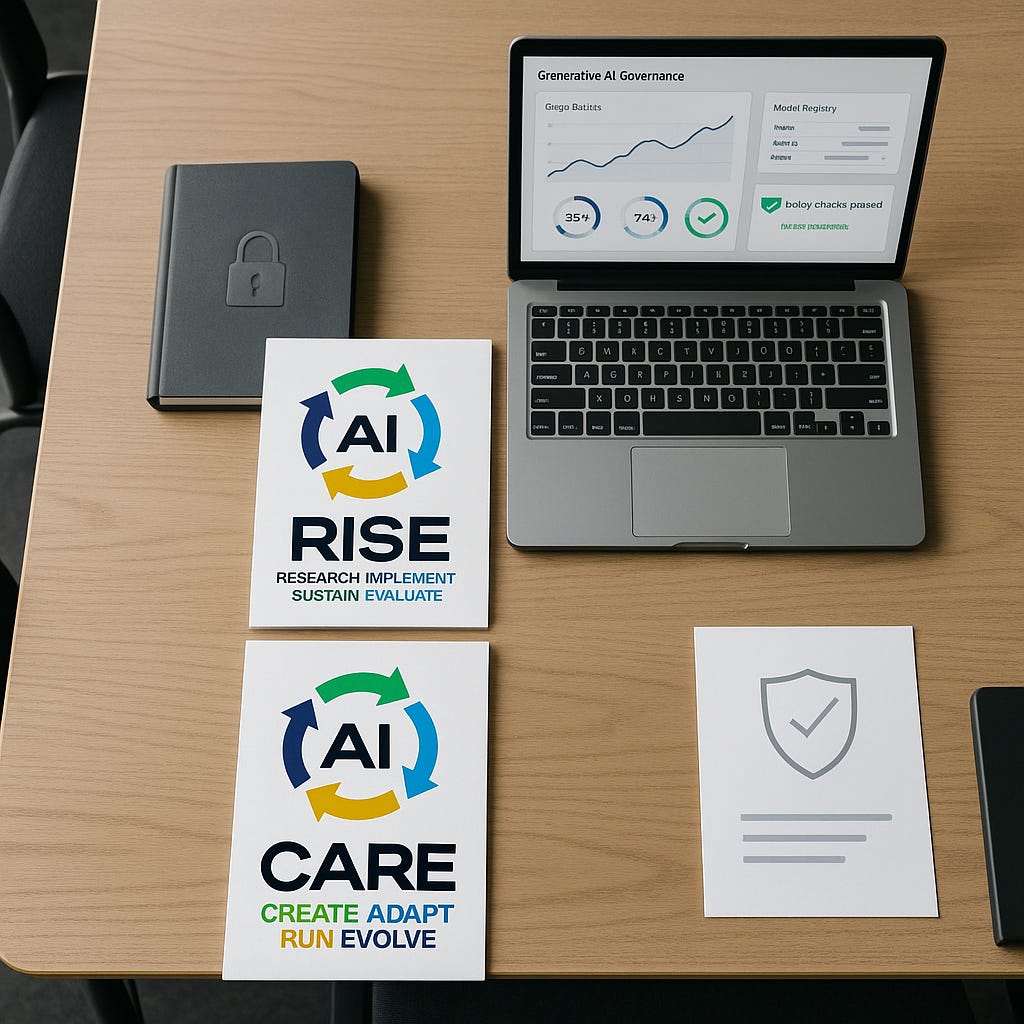Integrated AI strategy and governance or bust: why 95% of GenAI projects fail
Integrated AI strategy and governance that turn pilots into measurable value.
Integrated AI strategy and governance separates noise from results. Over the past year, enterprises poured tens of billions into generative AI, and roughly 95 percent reported no profit impact. That gap is not a model problem. It is a strategy and governance problem. This piece brings the MIT findings to the forefront, connects them to boardroom decisions, and shows how an integrated AI strategy plus disciplined governance turns pilots into measurable value you can defend.
What the MIT data actually says
The headline is blunt. A recent MIT study reported that about 95% of companies saw no measurable profit gains from generative AI initiatives, despite heavy spending and wide adoption of tools across the enterprise (Economic Times summary). The same reporting notes that more than 80% of large firms tried GenAI in some form, yet value failed to show up in earnings for the vast majority. Follow-on analysis warned that this AI ROI gap is shaking investor confidence because capital markets were pricing in future AI gains that have not arrived.
Why the miss? The study and industry reporting point to five recurring causes:
Unrealistic expectations set by hype. Pilots promised step-function gains that never came through at production scale.
Poor integration with day-to-day workflows. Generic models did not fit the real work employees do, so pilots stalled before scale.
Lack of domain adaptation. Teams relied on off-the-shelf models rather than being grounded in company data and tools.
Pilot purgatory. Many projects looked good in a demo but failed to launch because funding, ownership, or risk controls were missing.
Data quality and control debt. Dirty data, privacy concerns, and weak guardrails forced teams to pause or abandon projects.
Treat this as a system failure, not a fluke. When nearly everyone experiments and almost no one makes money, the missing piece is not technology. It is an integrated program that aligns strategy, risk, data, people, and finance from the start.
AI governance is the operating system for value
AI governance isn’t a binder that sits on a shelf. It is the business system that decides what you are allowed to build, how you will build it, and when you will roll it back. The absence of that system shows up in the numbers. Multiple surveys in the past year found that only a minority of enterprises have operational AI governance, even while deployments accelerate. Boards admit they are still building fluency, and many don’t place AI on every agenda. That gap maps cleanly to the high failure rate.
Make AI governance visible and actionable across the lifecycle:
Policies that define allowed uses, risk tiers, and decision rights.
Model and data inventories with owners.
Human-in-the-loop for high-risk or material decisions.
Security, privacy, and abuse testing before release.
Monitoring, incident playbooks, and retirement criteria.
This is how you convert experiments into operations.
For ongoing how-to, you can reference primers on RockCyber and weekly pieces in RockCyber Musings.
Integrated AI strategy: five decisions that prevent waste
Strategy is choices with consequences. Make these five choices before funding the next sprint.
Business outcome. Select two use cases with a clear P&L or loss-avoidance target in the next two quarters. Tie each use case to one revenue, margin, or risk metric.
Data reality. Name sources, owners, access rules, quality checks, and lineage. No data plan, no build.
Human roles. Define who reviews, approves, and audits the AI, and how the work shifts. Train people on the new workflow.
Risk posture. Set technical controls, red lines, and rollback criteria up front.
Economic gate. Decide the keep-or-kill rule based on unit economics.
Enterprises that match AI to concrete outcomes and run with discipline outperformed peers on earnings by several points in recent industry analyses. The math follows the method (Accenture).
Governance gap by the numbers
The governance deficit is measurable and costly.
Framework adoption is low. Reports through 2024 show that only a small percentage of firms had implemented AI governance frameworks in practice, even though most had a policy draft (IAPP).
Boards are not ready. Most directors rate their AI knowledge as limited, and many boards do not discuss AI at every meeting.
Pilots die on the runway. Research across enterprises shows a large share of AI proofs-of-concept never reach production, with many abandoned due to cost, data, and risk issues (Economic Times summary).
Security incidents erase thin gains. Global average breach cost is $4.44M, rising to $10.22M in the US; shadow AI adds $200K on average and pushes costs to $4.74M where it’s prevalent, versus $4.07M with little or none, and 97% of AI-related breaches lacked proper AI access controls (IBM Cost of a Data Breach 2025)
When strategy and governance are missing, ROI collapses and risk rises.
RISE + CARE: the strategy spine and the governance heartbeat
Keep frameworks practical and light. Use RISE to set strategy. Use CARE to run governance. Do not sell them. Use them.
RISE aligns AI to mission and economics, engages stakeholders, and sets a delivery roadmap with owners and milestones. It forces clarity about why the work matters, which bets to fund, and when to stop.
Research. Define the business outcome, value hypothesis, and success metrics. Map data, owners, quality, lineage, and legal limits. Set risk appetite and guardrails. Decide to build, buy, or partner. (Value tree, baseline, data map, risk register.)
Implement. Redesign the workflow first. Stand up secure environments, identity, secrets, logging, and private endpoints. Ground or fine-tune with your data. Write prompts as code with tests. Plan human review and red teaming. (Pilot runbook, evaluation dashboard, go-live, and rollback criteria.)
Sustain. Operate to targets. Monitor cost, drift, bias, and abuse. Rotate keys and review access. Keep a model registry and audit trail current. (Ops dashboard, FinOps report, access reviews, quarterly attestations.)
Evaluate. Tie KPIs to P&L or loss avoidance. Validate against the baseline. Decide to scale, tune, or retire. Report straightforward math and next steps to the board. (Value report, risk findings, scale plan, or retirement memo.)
CARE runs the lifecycle:
Create the rules and registries. Approve an AI use policy, a risk taxonomy, and a decision flow for high-risk use. Align to ISO 42001, NIST AI RMF, and the EU AI Act (ISO 42001, NIST AI RMF, EU AI Act updates).
Adapt to context. Ground and fine-tune with your data. Build prompts, tests, and red teaming that reflect your domain.
Run with controls. Gate releases, enforce human-in-the-loop for material decisions, monitor drift and abuse, trigger incident playbooks.
Evolve on cadence. Audit quarterly. Retrain or retire. Tighten controls as evidence accumulates.
Only a minority of enterprises have operationalized a loop like this. The ones that have are not part of the 95%.
Workflow first, model second
Most failed deployments dropped a generic model into a broken process. Fix the process, then fit the model to the job.
Map the current state with stopwatch detail.
Remove waits, handoffs, and rework.
Engineer prompts like APIs with versioning and tests for accuracy, safety, and usefulness.
Add tools for retrieval, calculators, and policy lookups.
Capture human edits and outcomes to retrain on a schedule.
Leaders who ground models in their own data and pair them with tools reach production faster, with fewer errors, and avoid the pilot purgatory highlighted in recent surveys.
Build the guardrails into the work
Security debt will erase thin margins. Bake controls into design, not after launch.
Boundaries. Private endpoints, VPC peering, and no public internet paths for sensitive workloads.
Identity. Least privilege by project and environment, short-lived tokens, key rotation.
Data. Retrieval allow lists, minimization, and clear handling for sensitive attributes.
Content. Input and output filters, safety checks, and policy rules at the edge and in code.
Observability. Logs for prompts, responses, vectors, tools, and downstream actions with retention that matches risk.
Adversarial testing. Prompt injection, data exfiltration, jailbreaks, and tool abuse. Red team with real attacks from your environment, not lab toys.
Many projects get abandoned late because these controls were missing, and audits shut them down.
Measure value like finance, not theater
A faster draft is not valuable. Lower costs due to positive business outcomes are valuable. Design the measurement before you write a prompt.
Task productivity. Time saved and quality uplift against a locked baseline.
Process metrics. End-to-end cycle time and error rate.
Unit economics. Cost per ticket, lead, claim, or order. Conversion lift.
Risk reduction. Fewer incidents, faster detection, lower loss per event.
Classic ROI and NPV wobble on AI because models decay and risk is asymmetric. Use depreciation-adjusted NPV for model and infrastructure decay. Use a risk-adjusted NPV that prices privacy, security, and regulatory shocks. If the math works, scale. If not, stop.
For practical templates, see the governance resources on RockCyber and examples in RockCyber Musings.
A 90-day integrated plan
This is a sprint, not a saga. Keep it tight. Show numbers.
Days 1-15: Decide and draw the lanes
Agree on two use cases with P&L line of sight. Freeze the rest.
Approve AI use policy, data handling standard, and a risk taxonomy.
Inventory models, vendors, datasets, secrets, and access.
Define value metrics and the keep-or-kill rule.
Days 16-45: Build the spine
Stand up private endpoints, identity, secrets, logging, and dashboards.
Define ground truth datasets, retrieval rules, and evaluation sets.
Write prompts as code with tests.
Draft human review criteria and playbooks for incidents and abuse.
Days 46-75: Prove it
Ship to a small group of power users.
Run A/B tests and capture edits.
Red team weekly and fix.
Report value and risk every Friday to the steering group.
Days 76-90: Decide and scale with discipline
If the math works, scale by 10x users and add training, runbooks, and on-call.
If not, shut it off, publish what you learned, and move to the next use case.
This flow addresses the root causes flagged by the MIT reporting: false expectations, poor integration, missing ownership, and weak controls. It replaces noise with a program that boards and auditors can trust.
The MIT finding that 95% of GenAI projects fail is a governance and strategy indictment. It’s a wake-up call. Integrated AI strategy and governance turn pilots into value you can measure, defend, and scale.
Call to Action
👉 Book a Complimentary AI Strategy Review
👉 Subscribe for more AI security and governance insights with the occasional rant.




